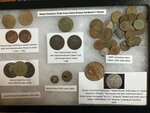

Philip S. Getty thinks of his metal detecting passion as “dirt fishing.”
“It is a bit like fishing,” the Solebury man says. “You feel a slight tug and instead of a bass, it’s a pull tab or a piece of tin. But you go a bit farther and it’s a bigger tug, ‘a find,’ something historical.”
Unlike many metal detectorists, who are seeking to reap treasure from the soil for themselves, Phil always gives his finds to the property owner. He labels them and presents them in a little glass box. (Detectorists is not a dictionary-quality word but it does serve to separate man from machine.)
His own reward? He seeks neither silver nor gold. “To me,” he said, “it’s really about the story.” He recalls, for example, finding little droppings of lead in a campsite used by Washington’s army and soon found himself picturing a soldier making his own lead bullets, readying himself for battle. “That’s the only explanation I could think of,” he said.” That image lingers.
“My first metal detector was a gift from my grandfather 50 years ago when I was a kid,” Phil said. The gift produced a passion that has endured and flourished. That simple detector has been replaced with a much more sophisticated one.
Phil also has more time to spend on his hobby now that he’s retired. He worked for more than a quarter century as an environmental hydro-geologist with a local civil engineering firm now called LVL Engineering.
He thinks of his detecting as “bridging the gap between archeologists and field work, acting like a scout to document and preserve finds for the landowner.”
He said, “I’ve been helping the Delaware and Raritan Greenway in New Jersey. “The goal is to document the finds before someone else comes in and snatches them for themselves. It’s amazing how quickly we can lose our history.”
He’s searched, and found historical pieces at Point Breeze in Bordentown, where Joseph Bonaparte, Napoleon’s older brother, lived from 1816 to 1839. The D and R Greenway owns and has preserved the 85-acre estate.
There, Getty has dug up three centuries of coins as well as some spoons, and a toy soldier.
Among them are a mid-18th Century King George II farthing displaying a harp on the reverse side, signifying its distribution in Ireland, and a New Jersey copper coin from 1788 when some states were still minting their own coins. He also found random metal objects and 20th century coins. It’s rare to find older coins, he said, because people usually did not carry them, instead running a charge at a local shop.
Getty’s finds are on display in the Gardener’s Cottage at Point Breeze.
It’s a perfect place for them. He’s intrigued not only with what lies buried in the soil but also what’s blooming above it.
He and his wife, Mary M. Michaels, a landscape painter, have created a gorgeous wildflower garden at their home. Phil also co-hosts, with Carl Molter, “Into the Garden” on WDVR radio on Wednesdays from 5 to 6 p.m.
He also is clerk of property at Buckingham Friends Meeting, and has, of course, dug up some interesting pieces at the 300-year-old site on Lower York Road.
Kathryn Finegan Clark is a freelance writer who lives in Durham Township. She can be reached at kathyclark817@gmail.com.
Join our readers whose generous donations are making it possible for you to read our news coverage. Help keep local journalism alive and our community strong. Donate today.